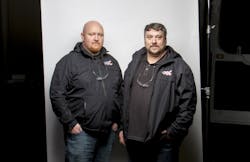Charlie Fought and Dan Reichenbach first met in 2005, while pursuing MBAs at Willamette University in Salem, Ore., and considering how to turn money-making dreams into practical reality.
Not long before their MBAs were completed, Reichenbach caught wind that the owner of Pacific Service Center—whom he knew through a vendor for which he previously worked—in nearby Portland was eager to sell his business. And Reichenbach was certain that he and Fought should pounce on the opportunity, despite little industry knowledge, particularly regarding the 18-wheel tractor/trailer combination vehicles the shop primarily repaired.
“I’ll admit,” Fought recalls with a laugh, “when he approached me with this idea, my basic answer was, ‘What the hell am I going to know about trucks?’ … My background was completely the opposite of the body shop business.
“So, I basically learned the trade while purchasing the company and getting my feet wet.”
But the two had a long-term plan, and 10 years after purchasing Pacific Service Center (PSC), Fought and Reichenbach’s business is thriving with annual revenue sitting at $4.3 million. One key reason: Pacific Service Center’s unique diversity of services. Long-term viability as an independent operation relied on expanding the business and offering more reasons for customers—90 percent of which are fleet—to come to PSC, the two owners say. The transformation didn’t take place overnight; instead, it was an incremental push, as PSC slowly built its success and expanded its reach over a five-year period.
SERVICE ADDED
Fleet pick-up and delivery service
YEAR IMPLEMENTED
2007
INVESTMENT
The implementation of this service occurred incrementally. Pacific Service Center (PSC) started with one tractor and one commercial driver and now runs nine tractors and 30 part-time and full-time drivers.
INTEGRATION PLAN
From the day they took over at PSC, Fought and Reichenbach quickly embraced business “diversification” with open arms. A decade later, Fought and Reichenbach now oversee three PSC facilities (all in close proximity to Portland’s airport) offering a wide array of services.
Because PSC’s work mix leans heavily toward fleet accounts, Reichenbach says that the shop is always focused on providing the highest level of customer service for its fleet partners. For example, if an account has 25 units requiring work, the shop is set up to handle that volume.
“In the commercial world, time is money,” Reichenbach says. “Our customer base cannot afford to send a driver to drop off a unit for repair, [so] we developed a model that would allow us to do this for the customer.”
In order to keep up with demands from customers and cover overhead costs, PSC began to purchase its own equipment to transport trailers. Today, the shop has nine of its own tractors and 30 drivers, who utilize the tractors to pick up the trailers and bring them to the shop. In the rare cases where the units are not driveable, a subcontracted tow company brings them to the shop.
ROI
The transportation arm is all about customer service, rather than a profit center, Reichenbach notes. PSC’s chief goal with its transportation department is to provide solid customer service and cover overhead. However, that added convenience and value proposition for customers has led to an increase in fleet accounts.
“By transportation covering their expenses we can continue to offer free pick-up and delivery,” the owner says.
SERVICE ADDED
Vinyl graphics
YEAR IMPLEMENTED
2008
INVESTMENT
PSC’s owners say that their total initial investment in graphics consisted of adding a graphic designer’s salary, as well as an installer’s wage, an Adobe suite software package, and a printer.
INTEGRATION PLAN
PSC—which has seen its annual revenue increase from $1.9 million to $4.3 million over the last decade—added graphics to its business offerings because the shop had been outsourcing that service to other companies for a prolonged period. That made it difficult for the shop to manage both timelines and quality. Thus, Reichenbach and Fought decided to be proactive and eliminate a persistent problem.
For myriad reasons, though, graphics has been the toughest service for PSC to implement. Graphics currently accounts for 7 percent of PSC’s total revenue, ahead of the transportation arm (5 percent) but trailing services like collision repair (40 percent) and commercial upfitting (40 percent).
“Art is subjective, and most of the time very difficult to quantify and convince people there is a value to,” Reichenbach explains. “In the beginning, it was difficult for our own people to coordinate a graphic installation; the language was different, and the physical requirements were different.
“After years of working closely together, our teams developed a common language and respect, resulting in a seamless integration today.”
ROI
Reichenbach says it took nearly five years for PSC to see a return on investment from adding graphics.
SERVICE ADDED
Mobile mechanical repair
YEAR IMPLEMENTED
2010
INVESTMENT
A service truck with a welder generator, as well as a technician.
INTEGRATION PLAN
While adding multiple services might seem daunting for some shop operators, Fought and Reichenbach chose their new business offerings strategically, and didn’t stray far from their comfort zone.
“The services that we’ve taken on, I wouldn’t consider them too far away from what the core business is,” Reichenbach says. “It’s still dealing with vehicles, it’s still dealing with parts going on to a vehicle. I mean, it really dovetailed in well with what we had already been doing, which is creating custom solutions for people.”
PSC added mechanical repair because the collision department was buried in simple trailer repairs nearly a decade ago, and the Portland business eventually began losing jobs because of it. So, Fought and Reichenbach hired a tech and sent him out to customer sites to perform small repairs. In 2010, all mechanical work was moved to its own separate facility.
“It wasn’t more than six to nine months,” Reichenbach says, “and we had to put three service trucks on the road to keep up with demand.”
Fought and Reichenbach’s primary research tool when considering such business additions is their customer base. PSC works with multiple national fleets, and the shop’s co-owners have made a concerted effort to gather information through word-of-mouth. And, over the years, the co-owners have developed a more refined, formalized budgeting process when considering new business offerings.
“In order to consider anything new now, we must understand if there is a deficiency in the marketplace,” Reichenbach explains. “Next, we would determine where, physically, in our company this would happen, who would manage it, and how would we mine the sales channel? … We need to know we can make a sustainable profit.”
ROI
As Reichenbach alluded to, it took roughly 6-9 months for PSC to get its initial investment back after adding mechanical work.
SERVICE ADDED
Commercial upfitting
YEAR IMPLEMENTED
2012
INVESTMENT
The initial investment was over $500,000.
INTEGRATION PLAN
PSC’s owners readily admit that they didn’t exactly hit the ground running when it came to adding commercial upfitting. Simple things, like training customers about which PSC facility does which service, led to growing pains.
But, before long, upfitting sales ramped up enough that Fought and Reichenbach felt the need to add additional space, and they leased a 10,000-square-foot building.
“Today we are much more dialed in,” Reichenbach says with regard to upfitting.
One prime example of PSC’s upfitting work: the manufacturing of refrigerated vans, which involves putting a refrigerated unit in the vehicle. Clients include partners in the meat industry, for example. PSC also fabricates keg trailers for multiple beer distributors in its region.
Fought and Reichenbach said their business used to dabble in upfitting early in their time with PSC, simply due to the business’s customer base. Once they added a full upfitting department— and their knowledge of that service evolved to expert status—demand increased. PSC’s co-owners always ask themselves if their customers could truly benefit from a potential new service they’re considering, and how adding that business element might translate into dollars.
Because of that mentality and measured approach, PSC’s owners are confident their business is largely equipped for long-term success.
ROI
Since upfitting isn’t as closely aligned to collision as PSC’s other services, it has taken a while for the business to master it. The shop is just now beginning to see an ROI.
On that note, Fought says patience is the primary requirement when adding new services like upfitting.
“It’s a leap of faith, venturing out,” Fought says. “You just have to stay the course.”

